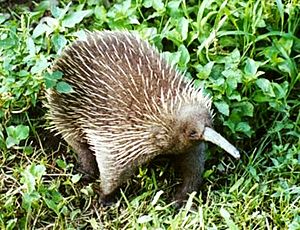Long-beaked echidna facts for kids
Quick facts for kids Long-beaked echidnasTemporal range: Miocene to present
|
|
|---|---|
 |
|
| Western long-beaked echidna (Zaglossus bruijni) |
|
| Scientific classification |
|
| Kingdom: | Animalia |
| Phylum: | Chordata |
| Class: | Mammalia |
| Order: | Monotremata |
| Family: | Tachyglossidae |
| Genus: | Zaglossus Gill, 1877 |
| Type species | |
| Zaglossus bruijni Peters and Doria, 1876
|
|
| Species | |
|
Zaglossus attenboroughi |
|
The long-beaked echidnas make up one of the two genera (Genus Zaglossus) of echidna. Echidna is a spiny monotreme that lives in New Guinea. There are three living species, and two extinct ones.
Echidnas are one of the two types of mammals that lay eggs.
Contents
General information
The long-beaked echidna is larger than the short-beaked and has fewer, shorter spines scattered among its coarse hairs. The snout is two-thirds of the head length and curves slightly downward. There are five digits on both hind and forefeet. Оnly the three middle toes on hind legs are equipped with claws. Males have a spur on each of the hind legs.
This echidna is primarily a nocturnal animal that searches for its insect food on the forest floor. The long-beaked echidnas feed primarily on earthworms rather than ants. The animal lives in dens and they are commonly found to be in burrows. The population of echidnas in New Guinea is declining because of forest clearing and overhunting, and the animal is much in need of protection.
Evolutionary history
The long-beaked echidna's posture is similar to a lizard, but the way the limbs move are very different. The echidna has a 45 degree swing while a lizard's is more horizontal. They also walk with two legs on one side of the body moving together.
Species
Zaglossus attenboroughi
- Habitat: regions of New Guinea at higher elevation than highland forests
- Era: the present
- Status: Endangered
Remarks: Species described from one sample only. May be endangered, or locally extinct. See Sir David's Long-beaked Echidna
Zaglossus bartoni
- Habitat:on the central cordillera between the Paniai Lakes and the Nanneau Range, as well as the Huon Peninsula
- Era: the present
- Status: Endangered
Remarks: see Eastern Long-beaked Echidna
Zaglossus bruijni
- Habitat: highland forests of New Guinea
- Era: the present
- Status: Endangered
Remarks: see Western Long-beaked Echidna
Zaglossus hacketti
- Habitat: Western Australia
- Era: Upper Pleistocene
Remarks: This species is known only from a few bones. At a metre long, it was huge for an echidna and for monotremes in general.
Zaglossus robustus
- Habitat: Tasmania
- Era: Pleistocene
Remarks: This species is known from a fossil skull about 65 cm long.
- Flannery, T.F. and Groves, C.P. 1998 A revision of the genus Zaglossus (Monotremata, Tachyglossidae), with description of new species and subspecies. Mammalia, 62(3): 367-396
- EDGE of Existence (Zaglossus spp.) - Saving the World's most Evolutionarily Distinct and Globally Endangered (EDGE) species
- Long-beaked echidna from ARKive
Facts Status Description Range Habitat Biology Threats Conservation Find out more Glossary References View all
See also
 In Spanish: Equidnas de hocico largo para niños
In Spanish: Equidnas de hocico largo para niños

